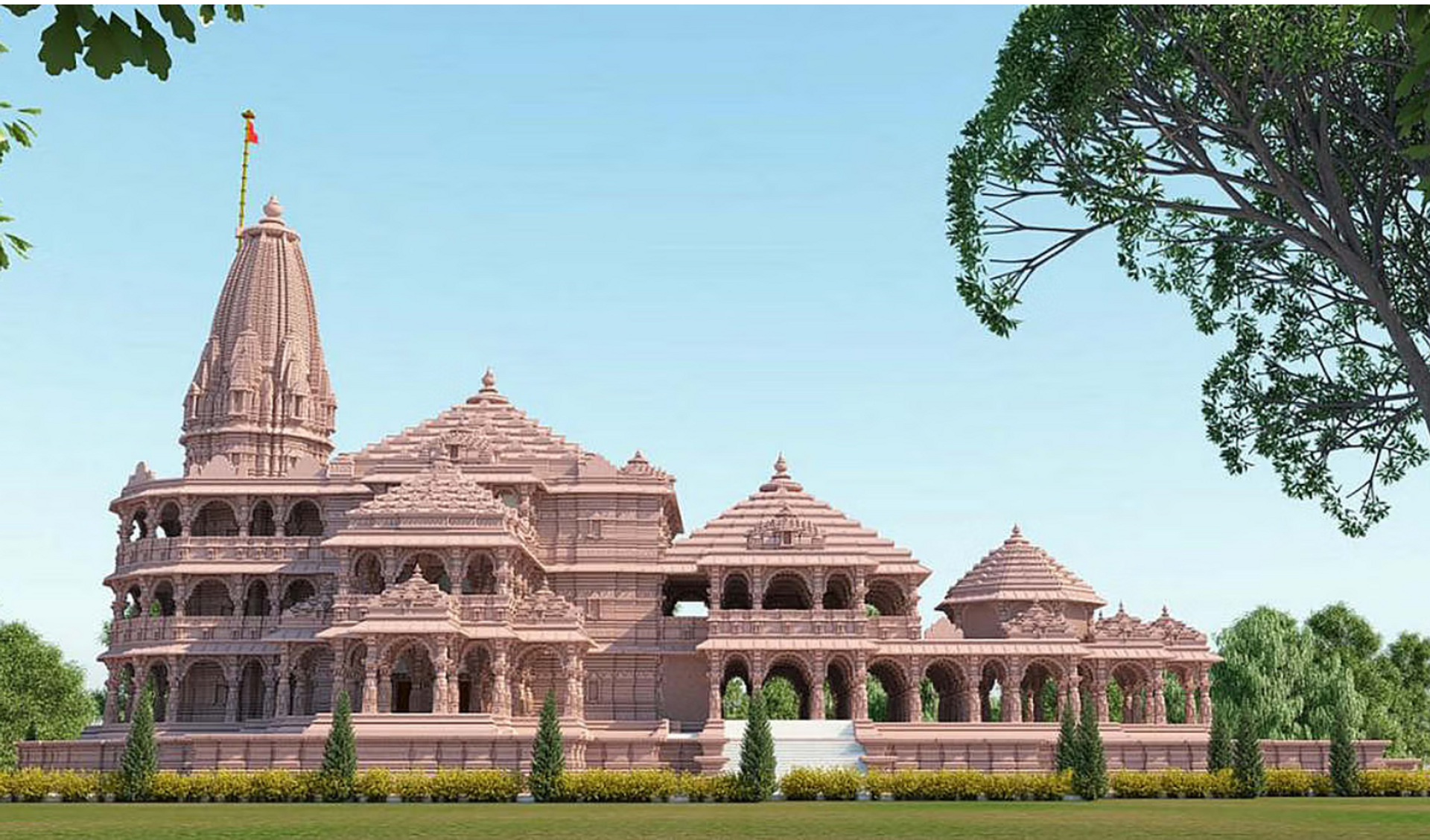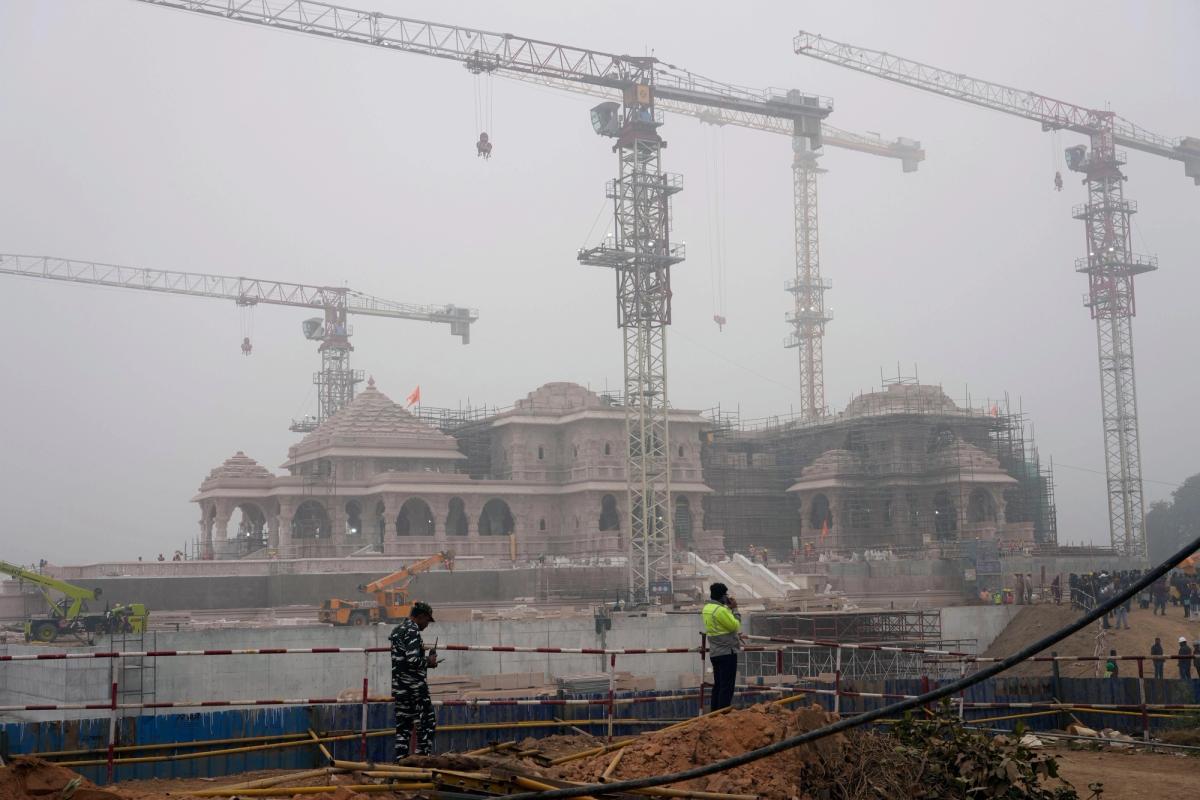The long-awaited consecration of the Ram Mandir, a grand Hindu temple in Ayodhya, northern India, will take place on 22 January, in an enormous ceremony due to be attended by many of the nation’s highest ranking officials. The temple is being built on the site of the former Babri mosque, which was controversially demolished by a mob of Hindu extremists in 1992. They were led by individuals affiliated to the far-right paramilitary organisation the Rashtriya Swayamsevak Sangh (National Volunteer Organisation, RSS) and its political wing, the Bharatiya Janata Party (Indian People’s Party, BJP), which now helms the country’s union government. Since the Hindu-nationalist BJP came to power in 2014, communal tensions in the country have intensified. Other mosques in India are increasingly facing the threat of destruction as well.
“The demolition of the Babri mosque was illegal and immoral,” says Anand Patwardhan, a documentarian whose 1992 film, Ram Ke Naam, charts the movement to demolish the mosque. He refers to the events in Ayodhya as an attempt to reimagine India. “Nobody is crying about the loss of a building structure,” he says. “It is the loss of our secular ethos.”

The Babri Masjid in Ayodhya, pictured before it was torn down by Hindu extremists in 1992
© Frederick M. Asher
The Babri mosque was a three-domed monument built in 1528, purportedly on the instructions of the Mughal king Babur. Since the 19th century, Hindus have claimed that the mosque was constructed atop a temple, on land that was the birthplace of the Hindu deity Ram. Members of the Hindu Mahasabha, a Hindu nationalist political group linked to the RSS, smuggled an idol of Ram inside the mosque in December 1949. Shortly after, the mosque was sealed by the government. In later years, members of RSS-affiliated groups led a campaign to erect a temple on the site. Finally, on 6 December 1992, the mosque was razed during an event in which leaders of the BJP and the RSS-affiliated organisation Vishva Hindu Parishad gave divisive speeches. At least 2,000 people, mostly Muslims, died in the outbreak of intercommunal rioting that it sparked—one of modern India’s worst chapters of sectarian conflict.
‘The politicisation of archaeology’
Over the following decades, the site of the razed mosque has been the subject of a complicated and much publicised legal battle—one that has been instrumentalised by India’s shifting political leadership. The BJP has long promised to build a Ram temple on the site, reiterating this aim in its manifestos for the 2014 and 2019 general elections. On 9 November 2019, the Supreme Court, India’s apex judicial institution, gave its final verdict in the case. The judgement was criticised by certain commentators as it deemed the acts of planting the idol in the mosque and demolishing the structure to be illegal but ruled in favour of the Hindu groups to build a temple on the site.
Experts have argued that there is no conclusive archaeological evidence of a temple having existed underneath the mosque. According to Robert Bevan, the author of The Destruction of Memory: Architecture at War (2006), the Ayodhya case demonstrates the “politicisation of archeology.” Across the world “the attachment of the archeological to the national or the ethno-nationalistic projects is a common thread”, he tells The Art Newspaper.

The proposed model of the Ram Mandir complex
A vast complex is being built to house the temple, which will measure 161 ft-tall and have five domes. In fact, several development projects are ongoing across Ayodhya due to the temple—and not without controversies. A number of its residents have reportedly claimed that these developments have unfairly displaced them from their homes. The Ram Janmabhoomi Teertha Kshetra, a trust charged with building the temple, “was willing to demolish any temples that were inconvenient to its designs and relocate them elsewhere”, according to the Indian current affairs journal The Caravan. While many news outlets have stated that the temple will be inaugurated on 22 January, its construction remains incomplete. It is being touted as a victory for the BJP in delivering on a key poll promise, shortly before India’s general elections, taking place in a few months.
Further threat to Islamic heritage
Patwardhan says the events in Ayodhya are emboldening people to foment similar tensions elsewhere. In recent years, multiple heritage sites, particularly mosques, have come under threat from Hindu nationalists. In early 2019, residents of Uttar Pradesh state, in which Ayodhya is located, attempted to bury a statue of Nandi—a bull-form that, according to ancient Hindu scripture, guards the entry to the abode of Shiva—near a wall of the Gyanvapi mosque, a centuries-old structure that shares a boundary with the Kashi Vishwanath temple. In mid-September 2023, four people were arrested for attempting to place an idol of the Hindu goddess Sarasvati within the premises of the Kamal Maula mosque, in Madhya Pradesh state. One of the arrestees, a Hindu Mahasabha activist, told The Caravan that the goddess had appeared to him in a dream “like she had manifested herself to those who found the idol of Ram Lalla at Ayodhya … If she had not done so there would have been no case, and there would have been no Ram Mandir”. Both disputes are currently underway in Indian courts.
In 2022, a case was filed on behalf of a local Hindu farmer—reportedly backed by the Hindu Mahasabha—alleging that the Shamsi Jama mosque, an 800-year-old national heritage site in Budaun, Uttar Pradesh state, was an “illegal structure” built on a demolished 10th-century temple of Shiva. That same year, a 300-old mosque that stood on a highway in Uttar Pradesh’s Muzaffarnagar district was destroyed. In January 2023, the Shahi mosque, a 16th-century mosque in the city of Prayagraj, Uttar Pradesh’s area, was bulldozed under a road-widening project.
“After the Babri Masjid verdict, the courage of communal forces has increased; their eyes are on our places of worship”
Most recently, on 24 December 2023, the New Delhi Municipal Corporation (NDMC) issued a public notice announcing that it has applied to the ministry of urban development’s Heritage Conservation Committee (HCC) to demolish the Sunehri Bagh mosque, a small Mughal-era structure located on a roundabout at the heart of central Delhi. According to the notice, this was “to ensure sustainable mobility” in the vicinity of the roundabout. It gave around a week’s time for objections to the proposal to be submitted.
DK Gupta, who runs a small snack shop beneath the mosque, tells The Art Newspaper that he has worked there for many years. He points out the lack of traffic in the area. “The government will only know why it is doing this now,” he says. The Sunehri Bagh mosque is listed by the HCC as a Grade III heritage site—a category for structures that evoke “architectural, aesthetics or sociological interest”. Development plans for the city of New Delhi during British colonial rule demolished several buildings but retained a number of sites of historical significance, including this mosque.
The Sunehri Bagh mosque is associated with the freedom fighter Maulana Hasrat Mohani, a member of the constituent assembly that drafted the Indian constitution in 1949, according to the historian and heritage conservationist Sohail Hashmi. Mohani was also a celebrated poet who coined the popular slogan “Inquilab Zindabad” (long live the revolution). “Every time the constituent assembly met, he used to stay at this mosque,” Hashmi says. Government officials offered Mohani an allowance for his stay in the capital, but, according to Hashmi, the freedom fighter refused: “I am a freedom fighter, I am not trying to get money out of it,” he is believed to have said. “The erasure of this mosque will erase all evidence of that. Just for that alone this building needs to be preserved. This is of historical importance,” Hashmi says.
“There has been a constant attempt to erode our mediaeval architectural heritage in recent times,” the Indian History Congress, a national-level organisation of historians, has stated in a resolution against the NDMC’s application. “After the Babri Masjid verdict, the courage of communal forces has increased; their eyes are on our places of worship” Arshad Madani, who heads a faction of the Muslim clerics’ body, the Jamiat Ulema-e-Hind, told The Telegraph India. “We will take every step for the security of the mosque; the administration should avoid committing illegal activities.”


